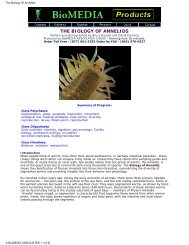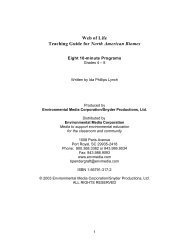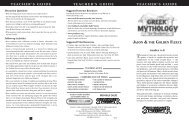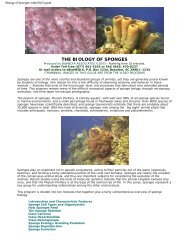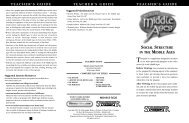CORTÉS & PIZARRO - Distribution Access
CORTÉS & PIZARRO - Distribution Access
CORTÉS & PIZARRO - Distribution Access
You also want an ePaper? Increase the reach of your titles
YUMPU automatically turns print PDFs into web optimized ePapers that Google loves.
Historical Overview<br />
Spain became a great European power in the 16th century, due to the vast<br />
wealth in precious metals that its explorers discovered in the New World.<br />
Spanish forces under the command of Hernán Cortés and Francisco Pizarro,<br />
two premier conquistadors, acquired untold riches in gold and silver from the<br />
Aztec and Inca civilizations of Central and South America. In the name of<br />
Christianity and the Spanish Crown, a small number of conquistadors conquered<br />
vast territory and peoples.With their superior weaponry and horses,<br />
Hernán Cortés overthrew Montezuma and the Aztec Empire, while Francisco<br />
Pizarro defeated Atahualpa and the Inca Empire, garnering land and treasure<br />
for Spain.As a result of the actions of Cortés and Pizarro, two of the most<br />
developed civilizations in the New World vanished.<br />
Time Line<br />
1513 — Francisco Pizarro reaches the Pacific Ocean with Vasco Núñez de<br />
Balboa.<br />
1518 — Hernán Cortés leaves Cuba for the Yucatán Peninsula in Mexico.<br />
1519 — Cortés lands in Mexico and begins his march on the Aztec, reaching<br />
the Aztec capital city of Tenochtitlán.<br />
1520 — The death of Aztec ruler Montezuma.<br />
1521 — Cortés conquers Tenochtitlán.<br />
1522 — The Spanish found Mexico City on the ruins of Tenochtitlán.<br />
1524 — The beginning of Pizarro’s first expedition to the Inca Empire.<br />
1526 — The beginning of Pizarro’s second expedition to the Inca Empire.<br />
1529 — Spanish king permits Pizarro to conquer the Inca Empire.<br />
1533 — The death of Atahualpa, the last Inca ruler, at Spanish hands.<br />
1535 — Pizarro founds Lima, the new capital city of the conquered Inca<br />
Empire.<br />
Vocabulary<br />
conquistadors — From the Spanish word for “conquerors,” this term refers to<br />
the Spanish explorers who were responsible for the European conquest of the<br />
New World, Mexico and Peru, particularly in the 16th century. Mostly commoners<br />
in their homeland, they sought fame and fortune in the New World. Overall,<br />
the conquistadors were considered to be a group of fierce and ruthless fighters.<br />
Aztec — A group of Central Americans who established a powerful, advanced<br />
empire in the area of present-day Mexico roughly one hundred years before<br />
being conquered by the Spanish led by Hernán Cortés.<br />
Yucatán — A state in the northern Yucatán Peninsula in southeastern Mexico.<br />
Cortés sailed from Cuba to explore the coast of Yucatán in 1518.<br />
(Continued)<br />
Tabasco — A state in southeastern Mexico where Cortés landed in 1519.<br />
Doña Marina — (c.1501–1550) Also known as “La Malinche,” an Indian<br />
princess given as a slave to Cortés and his men. Doña Marina became Cortés’<br />
translator, advisor and companion.<br />
Tenochtitlán — The capital of the Aztec Empire, which Cortés conquered in<br />
1521.<br />
Montezuma — (1466–1520) The ninth Aztec emperor who was held prisoner<br />
by Cortés and was killed during an Aztec revolt in 1520.<br />
noche triste — Spanish term for “sad night,” referring to the time when<br />
Cortés and his men were forced to retreat from the Aztec capital city and<br />
regroup before finally capturing the city and declaring Spanish rule.<br />
smallpox — An infectious disease characterized by fever, sores on the skin<br />
and often death.This disease was responsible for the deaths of many Aztec and<br />
Inca people in the 1500s.<br />
Vasco Núñez de Balboa — (1475–1519) A Spanish explorer and conquistador<br />
who was the first European to sight the Pacific Ocean, which he claimed<br />
for Spain in 1513.<br />
Inca — A group of powerful South Americans who ruled over a large empire<br />
that stretched for some 2,500 miles in northern South America, centered<br />
around today’s Peru. Francisco Pizarro was the Spanish conquistador who conquered<br />
the Inca people during the 16th century.<br />
Atahualpa — (c.1502–1533) The thirteenth and final emperor of the Inca<br />
Empire who was killed by the Spanish in 1533.<br />
Cusco — The capital of the Inca Empire, which was captured by Francisco<br />
Pizarro following Atahualpa’s death in 1533.<br />
Lima — The new capital of Peru established by Pizarro in 1535 after the<br />
defeat of the Inca Empire.<br />
Pre-viewing Discussion<br />
• Both Cortés and Pizarro conquered peoples who greatly outnumbered the<br />
Spanish conquistadors. How can this phenomenon be explained? Have students<br />
discuss possible reasons that might explain why the Spanish achieved<br />
their successes.<br />
• For the length of their conquests, Pizarro and Cortés remained faithful to<br />
their king and sent to Spain the great wealth they had gained from the Inca<br />
and Aztec. Brainstorm reasons why they didn’t keep the wealth for themselves.<br />
• Cortés and Pizarro engaged in many cruel, ruthless and aggressive behaviors<br />
to conquer native people and establish a Spanish empire.What character<br />
traits do you think these men possessed in order to accomplish these<br />
deeds? How might these men have justified their behavior?<br />
2 3<br />
Focus Questions<br />
1.Where was New Spain located?<br />
2. How large was New Spain in relation to Spain itself?<br />
3. Describe some characteristics of Aztec society.<br />
4.Why were slaves given to Cortés as a gift by native peoples he encountered<br />
as he landed on the Yucatán Peninsula?<br />
5. How was Doña Marina involved in the conquest of the Aztec Empire?<br />
6.Why did Cortés burn his own ships?<br />
7.What role did Aztec myth play in Cortés’ invasion of the Aztec Empire?<br />
8.Who was Montezuma and how did the Spanish treat him?<br />
9.Why did the Spanish retreat from the Aztec capital?<br />
10. How did the Spanish finally destroy Tenochtitlán?<br />
11. How was Cortés rewarded for his conquest?<br />
12.What type of ruler did Cortés become in New Spain?<br />
13. Describe some characteristics of Inca society.<br />
14.What does it mean to say that Pizarro “drew a line in the sand”?<br />
15.Who was Atahualpa and how did Pizarro interact with him?<br />
16. How did Pizarro consolidate Spanish control in the Inca Empire?<br />
17.Why did the Spanish build a new capital in Peru at Lima rather than use<br />
the old Inca city of Cusco?<br />
18. How did Pizarro come to his end?<br />
19. How did disease help the Spanish conquer the Inca and Aztec?<br />
Follow-up Discussion<br />
• Discuss with students what technology and cultural advantages the<br />
Spanish had over the native people of the New World that helped them<br />
make conquests with relatively small numbers of men. Could the Spanish<br />
have achieved their conquests if it had not been for disease?<br />
• Have students discuss whether they agree or disagree with Cortés’ decision<br />
to burn his ships at the beginning of his march on Tenochtitlán.Was<br />
this an effective decision? Would students have burned their ships if they<br />
had been in Cortés’ position?<br />
• Both the Aztec and Inca enjoyed advanced, sophisticated civilizations for<br />
their time and location; yet both empires were conquered by the Spanish.<br />
Have students generate suggestions for how these two cultures might<br />
have better met the challenges presented to them at the time of Spanish<br />
conquest.<br />
• Doña Marina was a powerful woman who, through her interactions with<br />
Cortés, had a significant influence on the development of world history.<br />
Encourage students to discuss Doña Marina’s role in history as a heroine<br />
or a traitor.<br />
4<br />
(Continued)



